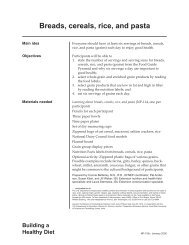Lesson Plan - Making family mealtime work - Kids a Cookin
Lesson Plan - Making family mealtime work - Kids a Cookin
Lesson Plan - Making family mealtime work - Kids a Cookin
Create successful ePaper yourself
Turn your PDF publications into a flip-book with our unique Google optimized e-Paper software.
Let’s imagine that I’m a parent and this is one ofmy children. We’re going to use some differentkinds of balls to show different ways we talkwith our kids.Throw the large ball over your partner’s head.Sometimes the way we talk to our kids goesover their heads. Maybe they are too young tounderstand the words, or to see the logic in whatwe’re saying.Throw the large ball low.Sometimes we talk down to kids.Throw the large ball far to the side.Often we avoid issues that need to be communicated.Someone is obviously feeling bad, orthere’s a <strong>family</strong> problem that needs to be talkedabout.Throw the large ball very hard (warn your partner!).When we speak in anger, give commands, ormake threats it can feel like being hit hard with ahard ball—for example, “Eat that now or else!”Have your partner turn his or her back. Throw the large ball.Talking or listening without giving our fullattention to the other person doesn’t accomplishmuch. Make eye contact with people.Throw cotton ball toward partner. Say the example in awhining tone.When we need to send a message but it isn’t firmenough, it’s not very effective—for example,“Billy, leave her alone.”Throw ping-pong balls all at once.<strong>Making</strong> <strong>family</strong> <strong>mealtime</strong> <strong>work</strong> — 3
When people in a <strong>family</strong> don’t stop to listen toeach other, there are too many messages and noone can pay attention. Sometimes as parents wealso give too many words or ideas at one time.Throw ping-pong balls one after another.Endless nagging or lecturing or too much talkingturns off kids—and adults. For example, yourkids may tune out if you say something like “Youdon’t know how good you have it. All you do isgo to school and come to supper. I had to stop atthe store, fix everything, and I’ll have to clean uptoo. Now you don’t even eat . . .”Throw the pine cone firmly (warn your parter!).Messages that hurt, criticize, put-down, givenegative labels, or tease about sensitive issuesare prickly and hurtful. Their sting doesn’t goaway easily—for example, “You don’t need anymore to eat. No wonder you’re so fat.”Throw tennis ball in a firm manner.Communication that’s firm but kind can makepeople feel safe. This communication doesn’tmake judgments. Here is an example. “Our<strong>family</strong> rule is that we sit down together even ifwe are not hungry.”Effective communication depends on:• listening not only to what is being said, but towhat is not being said;• being able to to communicate ideas, feelings,and emotions without threatening people; and• accepting and understanding anotherperson’s feelings.Optional: You also may use Are you a good listener?, includedin You can make <strong>family</strong> <strong>mealtime</strong> <strong>work</strong> (NP-104). Talk aboutparticipants’ answers to the questions. If you do not use theactivity, point it out to participants as something they can doat home.4 — <strong>Making</strong> <strong>family</strong> <strong>mealtime</strong> <strong>work</strong>
Main concept #3Family <strong>mealtime</strong> canimprove <strong>family</strong> nutritionPlace “Improve nutrition” on the display board.When families eat together, both children andadults are likely to eat a more balanced diet.Another way that <strong>family</strong> meals can improvenutrition is that parents can teach children aboutmaking good choices of foods from the foodpyramid. Here’s an activity you can try at thetable to teach about nutrition and have fun!Describe Activity #3 as follows.Many people have at least two names. Anotherword for our last name is our “<strong>family</strong> name”because we may share it with a parent or othermembers of our <strong>family</strong>. Foods have names too.Every food has its own name and a <strong>family</strong> namefrom one of the groups on the food pyramid—grains, vegetables, fruits, milk, meat, and fats.When you’re having a meal, have each personsay the name of a food on his or her plate. Forexample, “This is spaghetti. Its <strong>family</strong> name isgrains,” or “This is hamburger. Its <strong>family</strong> name ismeat.’’ When everyone has had a turn, have eachperson say the first name of the food again andhave the person next to him or her say the food’s<strong>family</strong> name.You can ask older children more questions, suchas “What other names might this food be called?What relatives does this food have (other foodsin the same group)?” Or you can ask, “Do wehave any foods from the grains <strong>family</strong> at thismeal?” and so on.If time allows, have participants try this activity using animaginary menu.6 — <strong>Making</strong> <strong>family</strong> <strong>mealtime</strong> <strong>work</strong>Children learn vocabulary from this game, it’s agood conversation topic, and everyone becomesmore aware of the variety of foods that make anutritious meal.
Main concept #4 Directions for Activity #4Family meals canhappen in manydifferent ways.• Ask participants to turn to Choose a <strong>family</strong> <strong>mealtime</strong> goal,included in You can make <strong>family</strong> <strong>mealtime</strong> <strong>work</strong> (NP-104).• Read the lists of suggestions, giving participants time tochoose one idea in each category (who, when, where, andwhat) to make a <strong>mealtime</strong> goal for the coming week.Participants can come up with other ideas if they aren’tsatisfied with the ideas that are listed. Have participantswrite their choices in the appropriate boxes.• The who, what, when, and where choices in the boxesmake up each participant’s goal. Ask for volunteers toshare their goals with the group. Then ask the followingquestions, allowing time for discussion after each one.What may get in the way of accomplishing yourgoal? How can you overcome those barriers?Who can help you?Set a mini-goalThis is your mini-goal for the coming week.When we meet again, we’ll talk about how youcarried out your goal.SummaryRepeat the main idea.Remember, <strong>family</strong> <strong>mealtime</strong> is any time that twoor more members of a <strong>family</strong> take time to eat inthe same place and share conversation.Our next meeting will be . . .Provide date, time, location, and topic for the next lesson.<strong>Making</strong> <strong>family</strong> <strong>mealtime</strong> <strong>work</strong> — 7












